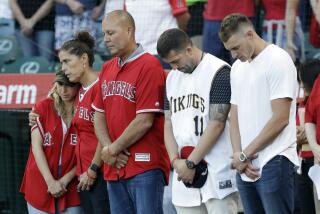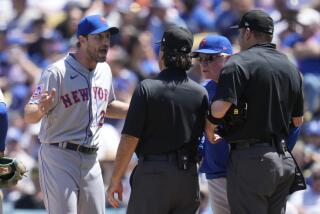Positive Spin to Testing Results
- Share via
PHOENIX — So, baseball now has a steroid testing program with a molar or two. By any test, that’s a positive.
If the program is flawed in some ways, as cynics are sure to point out, maybe they would prefer to have no program at all again.
Now, at least, there is the possibility of a meaningful deterrent.
Now, at least, there is the possibility that players still risking the use of the illegal drug will be fined or suspended after first receiving clinical help.
Now, at least, the identity of repeat offenders will be known.
Under the terms of the collective bargaining agreement that began this year, the guarantee of program testing and enforcement during the 2004 and 2005 seasons kicked in when 5% to 7% of the 1,438 random tests in the 2003 survey year were positive, surpassing the 5% threshold.
To be sure, it is difficult to know what to make of that 5% to 7% figure.
On the one hand, there is probably a far higher percentage of players still using.
It was common knowledge, after all, that testing would begin in spring training, and it stands to reason that some users were wise enough to know when to cycle off.
In fact, one general manager greeted the 5% to 7% news with incredulity.
“You’ve got to be kidding,” he said, stunned that any player would be, well, stupid enough to be caught when the parameters of the testing calendar were well known.
On the other hand, no matter how many players cycled off and avoided detection, no matter how many times 5% to 7% is multiplied out, the figure probably falls short of the claims by Ken Caminiti and Jose Canseco that more than 50% of big league players are using steroids.
Make no mistake: There is ample reason to believe that injection and ingestion had as much to do with the powerball explosion of the last 20 years as barbells and bench presses.
In fact, many in baseball believe that the falloff in home runs this season was the direct result of decreased steroid use because of the sample testing, underscoring in turn how rampant steroid use contributed to the assault of previous years.
Still, 5% to 7% positive tests -- no matter the conditions and criteria and the number of scientists labeling it a dark day for baseball -- isn’t enough evidence to say the slugging records of the last two decades have been tainted and should be thrown out.
We are where we are, and the next two years may provide an ongoing gauge of how home-run production relates to steroid use.
A year-round program including off-season testing would certainly be a stronger deterrent, but there were many who doubted that baseball and the players’ union would ever adopt any testing program.
The union opposed it for privacy issues. Management gave lip service in support of steroid testing while privately failing to push for it as fans seemed to respond to the power pyrotechnics.
Ultimately, it was an issue neither side could ignore, and now, if management and the union tend to interpret the survey results differently, if they are strictly in the eye of the beholder, it is hard to argue this time with Commissioner Bud Selig.
Citing the long forestalled program, Selig expressed the hope that it had heightened the awareness of the danger of improper drug use and that it will ultimately “allow us to completely eradicate the use of performance-enhancement substances in baseball.”
Well, you have to start somewhere, and 5% to 7% is a positive start in more ways than one.
*
Steroid Penalties
Major League Baseball penalties for steroid use starting in 2004:
*--* * First positive test: Player enters a certified treatment program. * Second positive test: 15-day suspension or up to a $10,000 fine. * Third positive test: 25-day suspension or up to a $25,000 fine. * Fourth positive test: 50-day suspension or up to a $50,000 fine. * Fifth positive test: One-year suspension or up to a $100,000 fine.
*--*
Note: All suspensions are without pay.
(BEGIN TEXT OF INFOBOX)
League Rules
The drug policies of some major U.S. sports leagues:
MAJOR LEAGUE BASEBALL
* Starting next year, all players will be tested for illegal steroids. The first time a player tests positive, he is placed in a treatment program. For subsequent positive tests, penalties range from a 30-day suspension to a one-year suspension without pay or fines of $10,000 to $100,000. Testing will continue until the positive tests drop below 2.5% in two consecutive years.
NBA
* Rookies are tested up to four times a season, and veterans are subject to one random test during training camp. Prohibited substances include amphetamines, cocaine, LSD, opiates, PCP, marijuana and steroids. Penalties ranges from game suspensions to lifetime bans.
NFL
* Steroid use is banned. Players are randomly tested and those testing positive could face game suspensions.
NHL
* There is no mandatory drug-testing policy. The only drug testing that is done is for players who are already in the league’s substance abuse aftercare program. Players who are abusers can seek help the first time without being exposed or suspended.
NCAA
* Athletes are randomly tested at NCAA championship events and football bowl games. Banned substances include cocaine, amphetamines, ephedrine, anabolic steroids, diuretics, heroin, marijuana, peptide hormones and urine manipulators. Athletes who test positive for any banned substance are ruled ineligible by their schools for at least 365 days and lose one year of eligibility.
BOXING
* Varies by state, though most don’t test boxers. Nevada began testing boxers last year for illegal steroids, and urine samples are checked for 25 different steroids.
-- Associated Press
More to Read
Go beyond the scoreboard
Get the latest on L.A.'s teams in the daily Sports Report newsletter.
You may occasionally receive promotional content from the Los Angeles Times.










